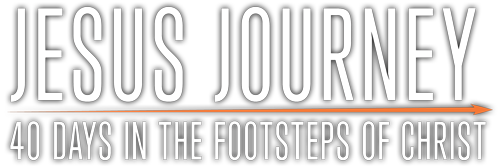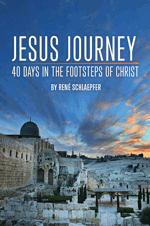Day 37
Excavating the Empty Tomb
Read Luke 24:13–53; John 20:10–17
A beautiful shaft of light beams down through the domed roof.
Hundreds of voices speaking different languages and dialects mingle and echo in the stone-surfaced church creating a beautiful noise. I imagine it’s how God might hear all our prayers.
We’ve returned with a great crowd of pilgrims swirling into the center of the Church of the Holy Sepulcher in the old city of Jerusalem.
As unlikely as it seems to modern visitors, most church historians think this is likely to have been the actual location of the crucifixion and tomb of Christ.
And ironically, it was a vehemently pagan Roman emperor who preserved our knowledge of the site.
BURYING CHRISTIANITY
Hadrian, a Caesar who despised Jews and Christians, decided to crush both faiths once and for all.
He made Jerusalem off limits to Jews.
Changed the name of the city to Aelia Capitolina.
Remade it in the Roman style, with colonnaded sidewalks.
And he placed pagan temples over the sites Christians venerated most: the place where Christ was crucified, and the nearby tomb.
This was in 135 AD, about one hundred years after Christ was crucified. Hadrian built a huge retaining wall on all four sides of these neighboring sites and filled it in with dirt, and then on top of the dirt he built shrines to Jupiter and Venus.
JOURNEY OF REDISCOVERY
Two hundred years later, Christianity became legal. Constantine was the famous emperor of the time, and his Christian mother Helena journeyed to the Holy Land to uncover some of the sites that had been suppressed or buried by previous Roman administrations.
Some of the relics she found and sites she discovered were apparently merely the products of tradition and superstition, and not founded in any real preserved historical knowledge. However, she and her entourage did stumble upon some astounding discoveries. I’ve already told you about Bethlehem. Here’s the Jerusalem story.
Because local legend insisted that Hadrian’s temple to Venus was built over the actual tomb of Christ, Helena supervised its removal. The Jerusalem-based bishop Eusebius wrote that he was skeptical she would find anything under the tons of dirt. But he was there when workers found, much to his surprise, empty tombs from the first century.
One tomb in particular showed signs of early veneration. This was apparently the tomb that, at least in 135 AD when Hadrian buried it, Christians believed had once held the body of Christ.
To Eusebius, the unearthing of this tomb was reminiscent of the Easter miracle:
As soon as the original surface of the ground, beneath the covering of fill dirt, appeared, contrary to all expectation, the monument of our Savior’s resurrection was discovered. Then indeed the rediscovery of this most holy cave was like his return to life, in that, after lying buried in darkness, it again emerged to light, and afforded all who came to see the site a testimony to the resurrection clearer than any voice could give…. 45
Of course, we can’t know for certain whether this was the precise tomb of Christ, but it is indeed an actual, empty first-century tomb in the right location in the right city — and it encouraged Christians at the time, who had been oppressed for so long, to begin telling their story freely once more.
Other first-century tombs were discovered here, too. They were largely left intact, but the tomb venerated as Christ’s was cut away from the hillside and a chapel was built around it.
This whole episode reminds me that God can take even the most violently anti-god movement and turn it around and use it for his glory — and this is true in your life, too!
TRACES OF THE PAST
Constantine’s beautiful church surrounding the tomb was destroyed — then rebuilt — then destroyed again — and then rebuilt by the Crusaders in about 1000 AD. That is the church we’re visiting today. Some find it uninspiring, layered with centuries of odd decorations and confusing architecture, not to mention the pressing crowds.
But — if you know where to look — you can see traces of what was here before. I’m excited to show some of our group where to discover these treasures.
We slip past the crowds in the dome,
then through an old burned-out chapel,
then under a small doorway,
and there we see actual old tombs from the time of Christ.
They’re ignored by the vast majority of visitors to the church. But it’s in looking at these very humble, nearly hidden stone tombs that I get a sense of the holiness of the place — not in the busy, confusing attempts at splendor in the rest of the ancient structure.
And just as the church here has layers of construction and destruction that have obscured the first-century tombs, the story of the risen Christ can get encrusted with generations of decoration. We can forget the impact of that moment, the instant of shocking
recognition, when people who had just been grieving the gruesome death of their Lord realized he had truly come back to life.
SURPRISE!
I had a chance, the first time I was in Israel, to go inside another first-century tomb that had been discovered when road crews were widening a highway near Megiddo. This one even had a rolling stone near the entrance, just like the tomb described in the Bible.
I grabbed my camera, went inside, and took some shots. It was so quiet.
I laid down on the cool stone slab. With eyes closed, I quietly thought about what Jesus might have felt and smelled and seen, in a tomb much like this, at the moment of resurrection.
Then I heard a tourist bus pull up. And some people walking toward the cave entrance. And, well — I couldn’t resist.
I waited until they were just inside the door, before their eyes adjusted to the darkness, and then I jumped up, waving my arms, shouting:
“I’M ALIVE!!”
And after they beat me up, I was so glad I had that experience. I had the rare chance to sense a little of the shock of the disciples — and the playfulness of the risen Christ — when he pops right into gardens of grief and locked rooms and slow shuffling walks home, and gives people the thrill of a lifetime!
GOOD NEWS ANNOUNCED TO OUTCASTS — AGAIN
This is the climax of the whole Gospel story, the moment everything in Christ’s ministry has been pointing toward.
And just as the birth announcement of Christ was given to outcast shepherds, the resurrection news is given first to an outcast woman.
A recent PBS documentary on the Roman Empire confirmed that women in the first century were oppressed. Women were not allowed to be active in politics, so nobody wrote about them. Neither were they taught how to write, so they could not tell their own stories. 46 Women were usually uneducated, and were denied legal status equal to men.
But Jesus had always included women in his circle of followers. And now he appears first to a woman — and not just any woman.
Mary Magdalene had been a very troubled person, cured by Christ of “seven demons” (Luke 8:2, Mark 16:9). Her name is intriguing: People in those days were usually known by their family heritage, referred to as “son of Joseph” or “daughter of Jacob” or “wife of Abram” and so on. But this Mary was referred to merely as “Magdalene” meaning “of Magdala,” which was a very rough fishing village on the shore of the Sea of Galilee.
The ancient town of Magdala, or Migdal in Hebrew, is currently being excavated. Archaeologists have discovered the foundations of a tower there — it was apparently used to help fishermen spot schools of fish. This corresponds with the literal meaning of the word Magdala: “tower” or “fortress.”
That Mary was referred to only in reference to this town probably indicates that she had no family to call her own. Some have suggested that because of the strange actions she displayed while under the influence of the demons — extra-biblical traditions throughout the ages describe her as mentally ill or sexually promiscuous before Jesus healed her — she was considered persona non grata.
But should it surprise anyone that Jesus would want the greatest news scoop of all time to be given to her, an outcast? It’s the way he rolls.
CAST ASIDE FOR THE CASTAWAYS
And speaking of the way he rolls, John 20:1 says the stone had been “removed”
or “rolled away”
from the tomb. The word John uses there literally means “cast aside,” as in: flung, thrown, tossed.
It wasn’t tossed aside so that Jesus could get out. You see later that he can pass right through walls in his resurrected body. It was cast aside so the castaways could get in. So that his ragtag band of followers could see that the tomb was empty.
But Mary’s first reaction is not hope. She thinks someone has taken Jesus’ corpse. She lingers there, weeping. The one person who had given her dignity in life had apparently been desecrated in death. And she is alone again.
Then Jesus appears. And says a word that means the world to her: “Mary.”
Not “Mary of Magdala,” the place she’d been before he found her.
Simply “Mary.”
The label that stretched into her past was gone.
And, whether it’s the grief-stricken Mary or the anxiety-riddled disciples in the upper room, that moment, when they met the risen Jesus, electrifies them. Sets them free. Starts them talking. And no one can ever shut them up again.
RADICAL AND REAL
That’s because Jesus Christ’s resurrection is his validation and vindication.
Anyone can say anything about God that they want to. But how do you know it’s true? If you’re going to look for God’s stamp of approval on someone, resurrection from the dead would be a pretty significant stamp.
Jesus Christ’s resurrection means that all the stuff he’s been teaching — about God’s love, God’s care for the outcasts, God’s willingness to forgive sins, God’s disdain for “religion” and eagerness to lavish grace on the repentant sinner — all of that is true.
And it means that no matter what people do to you, there is certain hope even beyond the grave. It means there is always hope. Because you can be resurrected too.
HE SURPRISES US STILL
In the centuries since, the risen Christ has popped into other dark gardens and locked rooms, coming to people afraid and people ashamed and people grieving. They’re often surprised, and, like these first witnesses, similarly set free.
You called, you cried, you shattered my deafness.
You sparkled, you blazed, you drove off my blindness.
You shed your fragrance, and I drew in my breath,
and I pant for you.
I tasted and now I hunger and thirst.
You touched me,
and now I burn with longing for your peace.— St. Augustine of Hippo
Ponder
How does it change your life and attitude to know that Jesus rose from the dead and lives today, interceding for you, walking with you, and giving you strength?

 Buy Jesus Journey at Amazon.com
Buy Jesus Journey at Amazon.com